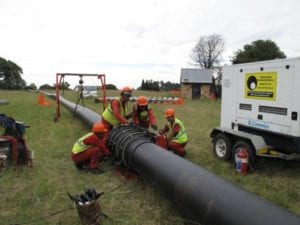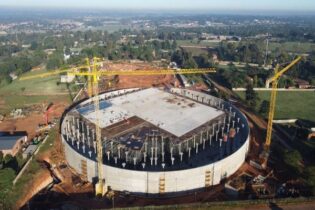Trenchless Technologies is celebrating its 20th anniversary in the directional drilling and pipe rehabilitation industry this year, indicating a certain tenacious faith, Trenchless Technologies’ Sam Efrat tells Chantelle Mattheus.
“One needs to be extremely tenacious and have a great deal of faith in order to overcome the many challenges one is faced with over the years. Trenchless Technologies is in business because from inception we managed to fill a need in the market to provide viable solutions and alternatives to conventional open-cut pipe laying,” says Efrat. Trenchless Technologies was registered in 1991 and in May 1993 commenced operations with a 3 t truck, a compressor, two earth piercing tools and some R80 000 in capital. “We began operating out of a studio at the back of my house in Berea, Johannesburg with five employees. Today, we have over a 100 employees, many of whom have been with us for 10 to 20 years, through ‘thick and thin’,” explains Efrat. Growth & gains The continued growth of the organisation can be attributed to the fact that it immediately filled a need in the market for boring small diameter holes beneath the roadway to install electrical conduits and water piping, using earth piercing or moling tools and pipe ramming, continues Efrat, adding that at first this was its “bread and butter”. In 1994, Trenchless Technologies acquired the Terra Hammer agency for Southern Africa and purchased a range of percussive hammers from 65 to 210 diameter, which allowed the company to undertake a full range of horizontal boring for pipes from 25 to 160 mm, pipe bursting from 110 to 315 mm as well as pipe ramming upto 400 mm. “We made good progress in pipe bursting (and to a lesser extent sliplining) for various municipalities that could see the benefit of not digging up their streets and pavements as well as the cost savings achieved, and our main focus for many years remained pipe bursting,” he states. He adds that in time, as technology improved, the company became more versatile and offered a wider range of more tailored solutions. “In 1997, we acquired the first of four horizontal directional drills, and in 2004 undertook our first CIPP (cured-in-place-pipe) project, followed in 2006 by SPR EX (Expanda) and SPR PE (Ribline) spiral wound piping and in 2011 SPE RO (Rotoloc). At present, we are also looking at fold and form solutions to further expand our range of services.” According to Efrat, to date some 400 km of trenchless work has been undertaken. “Since inception, we have experienced an average 20% year-on-year growth and expect this trend to continue, fuelled by the impending investment in water infrastructure needed to secure Southern Africa’s water resources, as well as the continued fibre optic network roll-outs.” He adds that he anticipates that the trenchless rehabilitation market is going to grow exponentially from a R500 million per year industry to a R5 billion per year one. “We also expect the horizontal directional drilling (HDD) industry to continue to grow in parallel to the fibre optic network roll-out; this will continue for several years with the ‘last mile’ and ‘fibre to the home and business’.” Achieving success The organisation’s greatest achievement to date, project-wise, has been the Port Elizabeth Goes Trenchless project, which won the ISTT Project Award for 2012. “This is the highest accolade available in the international trenchless industry, chosen from projects nominated from 30 affiliated trenchless societies worldwide,” explains Efrat.The project entailed the rehabilitation of two parallel sewers located in the heart of Port Elizabeth’s CBD and was originally designed to use the spiral wound technique throughout;, however, the team soon discovered that site conditions required also using CIPP and pipe bursting at certain locations. Altogether, we used five different trenchless techniques – spiral wound expanded to a close fit, spiral wound in-place, ambient CIPP, UV CIPP and pipe bursting, to successfully complete the project. .
“This project is an excellent example of using trenchless technology options to address unanticipated site conditions, allowing the project to be completed successfully without excavation and surface disruption,” says Efrat. The project that has been by far the most challenging – and interesting – to date for Efrat and his team is the ABSA Bank Energy Centre Sleeves Reticulation. This required the installation of 85 sleeves using HDPE pipe from 110 to 710 mm, up to 16 m deep, to connect several of ABSA Bank’s CBD buildings with gas, electricity, fibre optic, chilled and hot water. According to Efrat, challenges faced included:- The basement floors were designed to support the weight of a typical sedan vehicle. Consequently, propping was required from the floor below to add support to all areas over which the HDD drill needed to travel into the required position within basements.
- A floor to floor height restriction, requiring that all equipment be less than 2.1 m in height. Consequently, the Terra-Jet 7520 was refitted by removing the operator cabin, rebuilding the hydraulic oil tank at a lower position and lowering of the encapsulation body work such that the remodelled drill resembled a tank with a height of only 1.8 m.
- Some 65 installations took place in clay, while the remainder were in rock. This necessitated the use of percussive hammer and rock reamers to expand the holes to the required diameters.
- Lateral support ground anchors were encountered during drilling in dozens of locations. Their presence and position were not predictable, and resulted in drilling equipment becoming entangled in several instances. Drilling tools were pulled, pushed and rotated until they became free or broke the ground anchoring cables.
- In order to gain access to the drill face coring to remove concrete, lateral walls from 300 to 500 mm thick was required.








